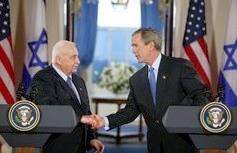Bush’s 2004 Middle East Vision Could Be Israel’s Nightmare
George W. Bush is the first US president to refer to the 1949 Armistice Lines in a formal statement on the Middle East conflict. This was the most striking and portentous US policy change to emerge from his joint news conference with Israeli prime minister Ariel Sharon after their White House talks Wednesday, April 14:
What he said was: Realities on the ground have changed over decades. In the light of those changes, including already existing major Israeli population centers, it is unrealistic to expect the outcome of final status negotiations will be a full and complete return to the 1949 armistice lines.
Final frontiers should be mutually agreed on the basis of these changes.
debkafile‘s political analysts examined the 1949 Armistice Agreements to find out why Bush departed from the usual pre-June 4 1967 Green Line locution. They found that the 1949 agreements, which were meant to stand only up until final peace settlements, left open or as demilitarized zones large and highly strategic areas of pre-1967 Israel, including the Hamma intersection of the Israeli, Jordanian and Syrian borders, the Nitzana region south of the Gaza Strip and abutting on Sinai in the Israeli Negev, the eastern half of the Israeli Arava from Tsofar south of the Dead Sea up to Eilat at its southernmost tip.
Putting these large chunks of Israel back on the negotiating table would provide a pretext for Egypt and Jordan to re-open its peace treaties with Israel and lay fresh claims to more territory. An even more dangerous twist could come about if the leaders of Israel’s two peace partners decided to renounce their claims in favor of enlarging a Palestinian state.
Therefore, whereas Sharon may have gained partial endorsement from Bush of some of the larger West Bank Jewish settlement blocs – “existing major Israeli population centers” – it came with a price tag that is far too steep for Israel to safely countenance: payment for those settlements by turning the clock back to a time when large tracts of territory in pre-1967 Little Israel were claimed and fought over by its Arab neighbors.
He praised Sharon’s willingness to begin removing certain military installations and settlements in Gaza Strip and Gaza Strip, but only because it offered the promise of territorial continuity for a future Palestinian state. Rather than endorsing Sharon’s disengagement proposals, he lauded Israeli pullbacks. Even Bush’s recognition of “major Israeli population centers” he predicated on the outcome of final-status negotiations.
The US President solemnly reaffirmed his steadfast commitment to “Israel’s self-defense capability including its right as a “vibrant Jewish state” to defend itself against terror. Yet he insisted that the security barrier Israel is building along the West Bank must be temporary rather than permanent so as not prejudice any final status issues including final borders.
The only real gain Sharon came away with from his oft-deferred White House visit was an assertion by the US president that Palestinian refugees should be resettled in a future Palestinian state rather than Israel. This effectively, though not explicitly, ruled out their right to return to lands and homes lost in the 1948 Arab-Israel war.
Bush called the Palestinians to task for failing to renounce terror and so disqualifying themselves from the Middle East political process and the attainment of statehood. They would regain a seat at the negotiating table only after abjuring terror and instituting a change of leadership that is committed to peace. It is very important, Bush stressed, for a Palestinian state to emerge “in which we have confidence, in which any prime minister of Israel has confidence, that it will be a peaceful partner.”
The Palestinian half of Bush’s June 24, 2003 Middle East vision therefore remains unchanged. However the Israeli half after ten months is unrecognizable.


